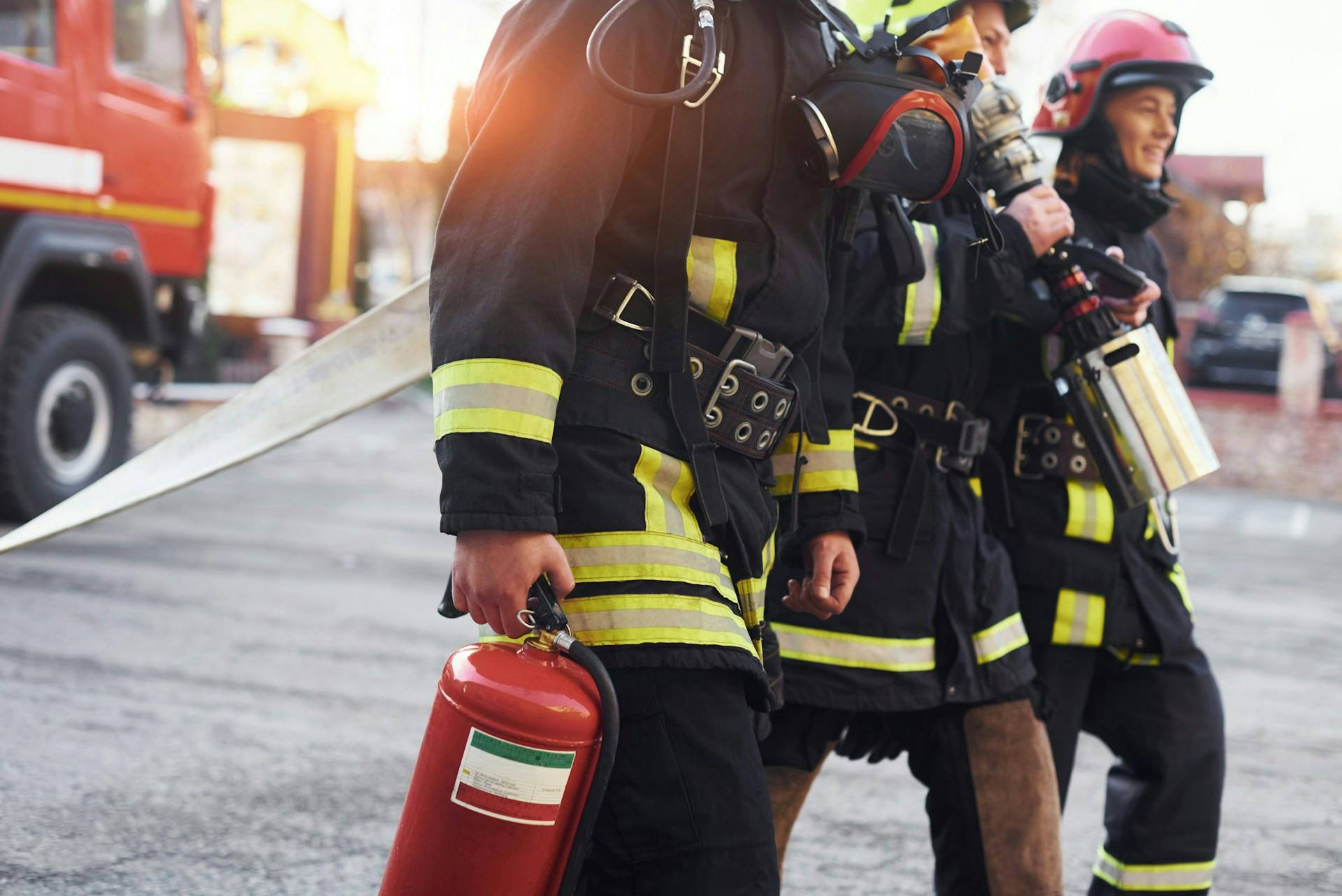Workplace Emergency Preparedness: What HR Needs to Know


Emergency preparedness at work remains necessary for every organization, yet communication during workplace emergencies can feel like shouting into the void, especially for non-desk employees who aren't constantly connected to company systems.
With over 300 billion emails sent daily—and only about 20% opened—urgent alerts simply vanish before reaching their intended recipients, highlighting the texting vs email gap in effective communication.
For workers without regular access to company computers, this gap becomes dangerous during emergencies when seconds count and their safety depends on receiving timely alerts through channels they actually use.
What is Emergency Preparedness at Work?
Emergency preparedness at work forms the backbone of an organization's ability to protect people and operations when the unexpected happens. It involves having workplace safety protocols in place for various scenarios, ensuring everyone knows what to do when a crisis strikes.
Workplace emergencies typically come in three flavors:
- Natural emergencies: Events like floods, hurricanes, and forest fires that come without invitation
- Work-related emergencies: The most common type—chemical spills, explosions, machinery failures, and gas leaks
- Civil emergencies: Less frequent but significant threats, including protests, strikes, and workplace violence
The stakes couldn't be higher, yet nearly 60 percent of American adults haven't practiced emergency response at work in the past year. This preparation gap leaves organizations vulnerable when disasters inevitably occur.
Strong workplace emergency readiness starts with identifying potential triggers specific to your environment. Common events that activate emergency protocols include IT outages, weather incidents, power failures, fires, security breaches, and health/safety incidents.
Proper emergency preparedness not only protects lives but also ensures business continuity. With clear communication channels and response protocols, organizations minimize damage while meeting their legal obligation to maintain a safe workplace.
Developing a Multi-Channel Emergency Alert System
Identifying Communication Needs
One of the toughest parts of emergency preparedness at work is reaching employees who aren't glued to desks all day. Effective communications for deskless workers is important when emergencies hit and chaos follows, as most team members won't have laptops handy.
To assess your organization's communication needs, you need to:
- Map out which employees work at desks versus those in the field
- Identify typical work locations and environmental conditions that may impact communication
- Recognize potential barriers in specific emergency scenarios, such as poor cell service or high noise levels
- Address privacy concerns by clearly explaining how employee contact details will be used
Infrastructure and Technology Solutions
A multi-channel approach becomes necessary—it reaches everyone during an emergency. The focus lies on using several communication paths at once so you can effectively alert an employee, ensuring your message breaks through the noise.
Effective channels include:
- Text messages (high open rates even during crises)
- Voice calls (for immediate alerts)
- Paging systems (for areas with poor connectivity)
When picking an emergency notification system, look for these necessary features:
- Simultaneous messaging across multiple channels
- Mobile accessibility
- Quick activation by designated staff
- Two-way communication capabilities
- Integration with existing internal systems
- Tools to track message delivery
- Pre-made templates alongside custom message options
Backup Systems
Even the most reliable primary alert system needs dependable backups, such as a mass notification system. During emergencies, standard communication can fail completely, making redundancy necessary.
Smart backup measures include:
- Cloud-based systems that work even if on-site servers crash
- Offline protocols that don't depend on digital infrastructure
- Designated emergency coordinators with backup communication devices
- Regular testing to catch potential failure points before they matter
Systems like the U.S. Emergency Alert System and Australia's Emergency Warning System demonstrate why layered approaches work. They use everything from sirens to texts, ensuring urgent information reaches people regardless of circumstances.
Your emergency alert system should also include 24/7/365 support resources. When a crisis hits and technical issues arise, immediate expert help can make all the difference.
Creating Clear Emergency Protocols
Designated Roles and Responsibilities
Emergency protocols serve as your crisis roadmap, providing structure when chaos threatens to take over. Their clarity determines whether you'll see a coordinated response or confusion when it matters most.
When creating emergency protocols, clear roles become necessary. Each team member needs to know their exact place in the communication chain to prevent both gaps and overlaps that could compromise safety.
An effective emergency communications structure might include:
- Group Administrators managing messages to specific employee groups
- Emergency Responders handling immediate crisis situations and relaying urgent information
- Information Officers distributing updates and maintaining current information
- Spokespersons communicating with media and external stakeholders
Smaller organizations might have one person oversee both emergency preparedness and communications, while larger organizations benefit from dedicated team members within a broader incident management structure.
A clear chain of command ensures information flows smoothly during emergencies. Regular drills help reinforce these roles, allowing team members to practice before facing a real crisis.
Language and Accessibility Considerations
Well-defined roles mean nothing if your emergency communications can't reach or be understood by everyone. Accessibility becomes fundamental to effective emergency protocols.
To make your emergency protocols work for everyone:
- Use multimodal communication combining text, audio and visual. Pair visual alerts with audio announcements for those with visual impairments. Make similar accommodations for any team members with similar disabilities to ensure safety for all.
- Provide information in multiple languages based on your workplace demographics to facilitate multilingual emergency communication. Implementing multilingual alert systems can greatly enhance accessibility and effectiveness. Platforms like Yourco offer SMS communication with AI-powered translations, effectively reaching your employees in the language they are most comfortable with.
- Make sure digital emergency platforms work with screen readers.
When preparing emergency protocols, remember that transparency builds trust. Clear communication about potential hazards and early announcements during emergencies helps maintain calm and ensures everyone can take appropriate protective actions regardless of abilities or language proficiency.
Training and Education on Emergency Procedures
Emergency training isn't just a compliance checkbox—it focuses on making sure everyone knows exactly what to do when seconds count. Consistent practice and genuine employee involvement creates a truly prepared workplace.
Regular Training and Drills
Organizations that run regular emergency drills experience a 50% higher success rate handling actual emergencies compared to those that skip this practice.
Different drills serve specific purposes:
- Evacuation Drills: Teaching everyone how to exit quickly and safely
- Lockdown Drills: Preparing staff for shelter-in-place situations
- Fire Drills: Practicing alarm response and extinguisher use
OSHA guidelines recommend emergency drills at minimum once per year, though high-risk environments need more frequent practice. Make drill timing somewhat unpredictable to better simulate real emergencies.
Refresh your training program when:
- New employees join your team
- Job roles change
- New equipment or processes arrive
- Facility layouts change
- Procedures get updated
- Drills reveal performance issues
After each drill, conduct a thorough debrief with all participants to identify strengths and weaknesses in your emergency response and make necessary adjustments.
Employee Participation and Engagement
For emergency training to stick, you need enthusiastic participation from your entire team. Interactive training methods dramatically outperform lectures for knowledge retention and practical application.
Try these engagement strategies:
- Scenario-based learning: Create realistic emergency simulations where employees practice responses in a controlled environment. This hands-on approach builds muscle memory for important procedures.
- Leadership involvement: When management visibly commits to emergency preparedness, employees follow suit. Make sure your leadership team actively participates in drills.
- Recognition and incentives: Acknowledge employees who show exceptional knowledge during emergency drills with certificates, small rewards, or recognition during team meetings.
- Technology integration: Modern tools like VR, AR, and mobile apps enhance engagement, improve retention, and reinforce emergency preparedness through interactive, hands-on training.
- Feedback channels: Create ways for employees to share input on training effectiveness through anonymous surveys, suggestion boxes, or open discussions.
Regular, thoughtful drills combined with genuine employee engagement strategies build a workforce that's truly ready to respond when emergencies strike. Remember that emergency preparedness at work isn't a one-time event—it's an ongoing process.
Post-Emergency Communication and Evaluation
After the immediate danger passes, your communication strategy needs to shift toward recovery and learning. The aftermath offers valuable chances to assess your systems and improve for next time.
Recovery Information and Updates
When the crisis subsides, your communication needs to focus on recovery:
- Centralized Information Distribution: Create a single source of truth for all recovery updates to prevent rumors and ensure everyone gets consistent guidance.
- Regular Status Updates: Provide scheduled updates about recovery progress, resource availability, and return-to-normal timelines. Consistency builds trust and reduces anxiety.
- Multi-Channel Approach: Keep using diverse communication channels (digital signs, mobile alerts and face-to-face communication) so recovery information reaches everyone regardless of location.
- Targeted Messaging: Customize recovery information for different groups based on their specific needs. Employees need different details than customers or community partners.
- Documentation: Keep thorough records of all post-emergency communications for later review and compliance purposes.
Review and Improvement
The post-emergency period is your window for honest evaluation:
- After-Action Reports: Create comprehensive reviews documenting what worked well and what needs improvement. Include detailed communication timelines and any gaps identified.
- Stakeholder Feedback: Gather input from everyone involved in the emergency response, including message recipients. Their perspectives often highlight blind spots.
- System Performance Analysis: Evaluate how your communication tools performed during the emergency. Were messages delivered promptly? Did any systems fail? Did backups work properly?
- Gap Identification: Look specifically for communication breakdowns—audiences who missed urgent information, technology failures, or unclear messages.
- Improvement Plan Development: Based on your findings, create a concrete plan to fix identified gaps through training, system upgrades, or protocol changes.
- Implementation Timeline: Set a schedule for improvements with clear ownership and accountability, prioritizing the most significant gaps first.
Systematically reviewing your emergency communication after each incident creates a cycle of continuous improvement that strengthens your organization's resilience over time.
Integration with Overall Emergency Preparedness Plan
Your emergency communication strategy must be fully integrated with your organization's broader emergency preparedness plan to ensure both effectiveness and legal compliance. In many places, emergency response plans aren't just best practice—they're legal requirements.
OSHA regulations may require your workplace to have an Emergency Action Plan (EAP) based on specific standards, especially for industries handling hazardous materials, fire detection systems, or specialized operations like grain handling. Your communication protocols must support the minimum EAP requirements, including:
- Reporting procedures for fires and emergencies
- Clear emergency escape procedures and route assignments
- Methods to account for all workers after evacuation
- Contact information for responsible individuals and external resources
- Procedures for workers who must remain for operations
Outside the US, countries have similar requirements. Canadian occupational health and safety legislation outlines essential emergency preparation and response requirements, with the Canadian Centre for Occupational Health and Safety providing compliance guidance.
When integrating communication strategies with your broader emergency preparedness plan, make sure they support transparency, early announcements, and trust-building—elements that both satisfy regulations and maximize effectiveness during real emergencies.
Connecting When It Matters Most
Effective emergency communication requires reliability and simplicity. For industrial sectors, traditional methods often fail to reach non-desk workers during emergencies.
An SMS-based approach, such as a text messaging service for business, offers practical advantages: no apps to download, no training required, and messages that actually get read. When emergencies strike, text messages achieve a 98% open rate compared to email's dismal 20%, ensuring your workforce receives time-sensitive safety information immediately.
Yourco's texting service connects directly with your non-desk workforce through the phones they already carry. During emergencies, send instant alerts to specific teams or your entire workforce, enable two-way communication for status updates, and maintain connection when other systems fail.
Try Yourco for free today or schedule a demo and see the difference the right workplace communication solution can make in your company.


